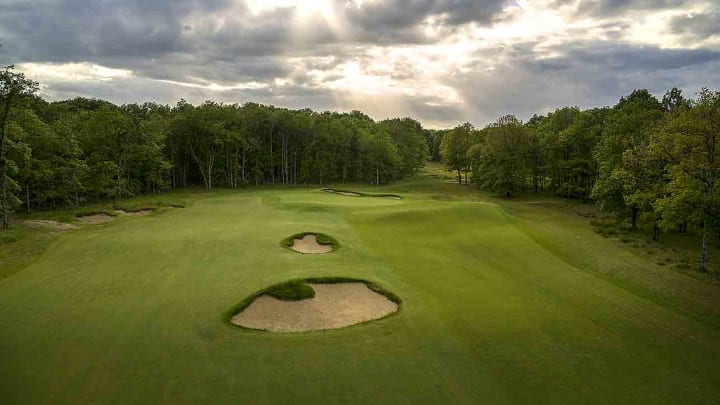Three French Golf Courses That Are Better Than the Olympic Course

When 60 of the world’s best male professional golfers tee off on August 1 in a quest for Olympic Gold, they’ll be competing on France’s finest tournament stage, the Albatros course at Le Golf National. However, the Olympic venue is nowhere near the best course in the country. In fact, it wouldn’t even make the medal stand.
Le Golf National resembles a brawnier TPC Sawgrass, notably in its amphitheater viewing areas and its risk-reward drama. Three of the final four holes are splashed with liquid peril, with not one, but two island greens, at 15 and 18. Ahead of Europe’s 17 ½ to 10 ½ Ryder Cup beatdown of the U.S. six years ago, Phil Mickelson observed, “I think it’s phenomenal because it’s got the best viewing of any golf course I’ve seen, as well as the risk-reward. The last four holes are spectacular.”
Nonetheless, this isn’t a golf course that elicits affection. Too many of the waterless holes are just dull slogs across an uninspiring landscape. If you’re looking for medal-winning golf, talk your way onto Morfontaine, Les Bordes (New) or Chantilly.
Gold Medal: Morfontaine
Tucked away in a nearly impossible-to-find forested location 40 miles north of Paris is Morfontaine, a time-warp retreat of the highest order. Its championship layout, the Grand Parcours, bears the design stamp of one of history’s most underappreciated architects, Britain’s Tom Simpson, whose other credits include Top 100 standouts such as Ireland’s Ballybunion and Scotland’s Cruden Bay.
Morfontaine measures just 6,640 yards from the back markers, yet its par of 70 is seldom battered. The opening handshake is anything but gentle: a 458-yard par 4, followed by a 202-yard par 3. Standout Simpson greenside bunkering elevates the 405-yard, par-4 sixth, while the dogleg-left, 428-yard, par-4 seventh checks every box—at least it did for GOLF magazine 25 years ago, when it selected the seventh as one of the 500 greatest holes in the world.
Morfontaine’s heathland appearance and personality ranks with London’s finest examples, such as Sunningdale and Swinley Forest. If the back nine doesn’t quite measure up to the front, you’re beyond caring. You’re so charmed by the sandy soil, gently undulating terrain, gorgeous pines and splendid solitude, all that you can think about is how happy you are to be aboard.
During World War II, Morfontaine played host to famous folks such as Bing Crosby, Gary Cooper and especially U.S. General Dwight D. Eisenhower, a frequent visitor. If you’re fortunate enough to land a tee time, you could easily be persuaded that you’ve returned to 1944. Architect Kyle Phillips has tastefully lengthened a fistful of holes, notably adding 65 yards to the 377-yard, par-4 10th and a similar number, via a new green complex, at the 563-yard, par-5 12th. Beyond those changes, Morfontaine remains a monument to low-key greatness.
Silver Medal: Les Bordes (New)
Approximately ninety minutes south of Paris sits France’s greatest modern golf layout, the New course at Les Bordes. This remarkable 2021 design from Gil Hanse and Jim Wagner is located 45 minutes southwest of Orleans, in the Sologne Forest of the Loire Valley, on one of the grandest estates in France. Until his death in 1994, Les Bordes was the home of Baron Marcel Bich. If you’re having trouble conjuring up the majesty of this estate, understand that Bich was the man who mass-produced the BIC ball point pen in 1950, the BIC disposable pocket lighter in 1973 and the BIC one-piece disposable razor in 1975. The place is plush.
Hanse and design partner Jim Wagner carved out a par-72 heathland layout of 7,391 yards that in places feels like Morfontaine on steroids. Yet, it’s more homage than copy. Hanse cites the sand and scale of Pine Valley and the National Golf Links of America as influences, but Les Bordes is a true original. Its fairways bleed into the natural sandy scrub, amid pines, oaks, birches and chestnuts and its greens display the kind of sophisticated contouring that makes every hole an entertaining adventure. It’s big, yet its strong suit is subtlety. Yet another exclusive, locked-gates playground, Les Bordes could well overtake Morfontaine as France’s best golf course. But we’re not there just yet.
Bronze Medal: Chantilly (Vineuil)
Those of you of a certain age may remember the 1985 James Bond film, “A View to a Kill,” where pivotal scenes revolved around the most stunning horse stable in creation. This was no AI parlor trick—this was the Great Stables, next to the Chateau de Chantilly, all “owned” by super-villain Max Zorin (played by Christopher Walken). Word began to spread that one could actually go visit this attraction. For golfers in the know, however, nearby Chantilly Golf Club was already on the map.
Tom Simpson revised the 11-year-old Chantilly Vineuil in 1920 and added a second nine. Over the next eight decades, it would host the French Open 10 times with winners that included Henry Cotton (1947), Roberto De Vicenzo (1950, 1964) and Nick Faldo, who went back-to-back in 1989-90.
Post World War II, this private (but accessible) club modified Simpson’s well-wooded, masterfully bunkered layout on several occasions, but it always played long—currently 7,047 yards, par 71—and strong, boasting a slope of 140. As testament to its challenge, Faldo’s seven-under-par total in 1989 was the lowest winning score of all ten French Opens played on Vineuil. So while this stern test 30 miles north of Paris (and a mere 12 miles northwest of Morfontaine) can be a brute, its pleasantly wide, forested confines offer tranquility among the ivy-covered oaks, pines and limes. As with our other French medal-winning courses, it’s superb golf—yet with a setting that would make for an ideal spot to picnic.
